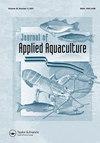光周期和温度对小品鱼Cheirodon interruptus卵巢成熟的影响
IF 0.8
Q3 FISHERIES
引用次数: 2
摘要
本文章由计算机程序翻译,如有差异,请以英文原文为准。
Effect of photoperiod and temperature on ovarian maturation in the small characid fish Cheirodon interruptus
ABSTRACT Cheirodon interruptus is a small characid widely distributed in South America and frequently used as bait. The harvesting of wild fish to supply the market has a significant environmental impact. The effect of photoperiod and temperature on ovarian maturation is assessed to evaluate its potential to manipulate reproduction. Fish were exposed to three treatments (in triplicate): (light hours: L/temperature: °C) 12 L/20°C, 24 L/20-25°C, and 9.8–13.3 L/20-25°C. Gonadosomatic index (GSI), plasma estradiol (E2), oocyte diameter, and vitellogenic oocyte percentage were estimated. Mean GSI, E2 values, oocyte diameter, and percentage were significantly higher in 9.8–13.3 L/20-25°C than in the other treatments, indicating ovarian maturation. In turn, these values were minimal in the 24 L/20-25°C treatment, revealing ovarian regression. These results suggest that in C. interruptus, the photoperiod is the primary driver of gonadal maturation and the temperature plays a secondary role. This study demonstrated that manipulation of ovarian development is possible through the design of photothermal regimes based on the winter-spring transition.
求助全文
通过发布文献求助,成功后即可免费获取论文全文。
去求助
来源期刊

Journal of Applied Aquaculture
Environmental Science-Ecology
CiteScore
3.20
自引率
0.00%
发文量
38
期刊介绍:
The Journal of Applied Aquaculture is a platform for the sharing of practical information needed by researchers to meet the needs of investors, farm managers, extension agents and policy makers working to adapt aquaculture theory to achieve economic and food security objectives in the real world. The journal emphasizes multi-disciplinary research and case studies that propose financially and logistically viable solutions to observable problems.
 求助内容:
求助内容: 应助结果提醒方式:
应助结果提醒方式:


